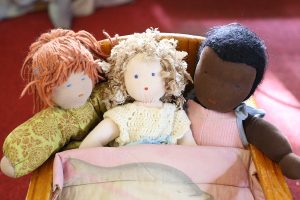Ever wondered why the dolls in The Kindergarten rooms have no facial expressions or features? This excerpt from the book Early Childhood Education And The Waldorf School Plan by Elizabeth M. Grunelius explains it beautifully:
‘Elaborate toys completed in every detail convey certain definite instructions as, for example, a doll with all parts of its face carefully painted, which tells the child to observe and remember its particular eyes, its particular nose, its particular smile. It leaves little or nothing to the child’s imagination. When play occasionally requires a doll to cry, the elaborate doll still has its determined, irremovable smile. Any set expression stands in the way of the flexibility which follows the changing moods of play. Particularly gifted and sensitive children often leave a new elaborate doll relegated to the toy cupboard after a few brief contacts with it and return to play with their old simple, dirty doll. The less finished and the more suggestive a toy may be, the less is its mere instructional impact and the greater its educational value.
Toys help children to re-enact experiences from life as they actually happen.

Regarding toys
As the muscles of the hand grow firm and strong in performing the work for which they are fitted, so the brain and other organs of the physical body of the child are guided into the right lines of development if they receive the right impressions from their environment. An example will best illustrate this point:
You can make a doll for a child by folding up an old napkin, making two corners into legs, the other two corners into arms, a knot for the head, and painting eyes, nose and mouth with blots of ink. Or else you can buy the child what they call a ‘pretty’ doll, with real hair and painted cheeks… If the child has before him the folded napkin, he has to fill in from his own imagination all that is needed to make it real and human. This work of the imagination moulds and builds the forms of the brain. The brain unfolds as the muscles of the hand unfold, when they do the work for which they are fitted. Give the child the so-called ‘pretty’ doll, and the brain has nothing to do.
(Elizabeth M. Grunelius was the founder of the first Kindergarten that was established at the original Waldorf School in Stuttgart, Germany.)


